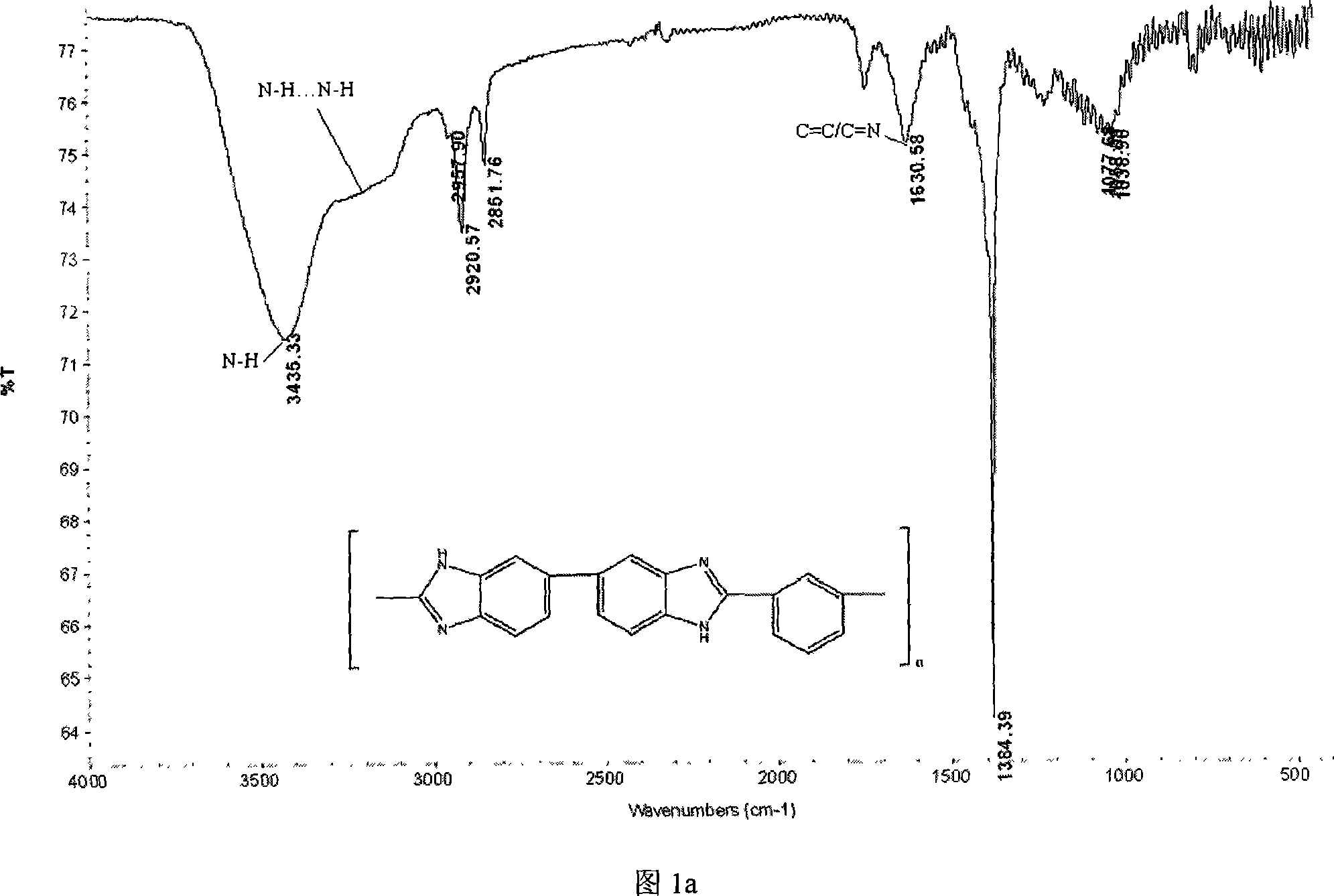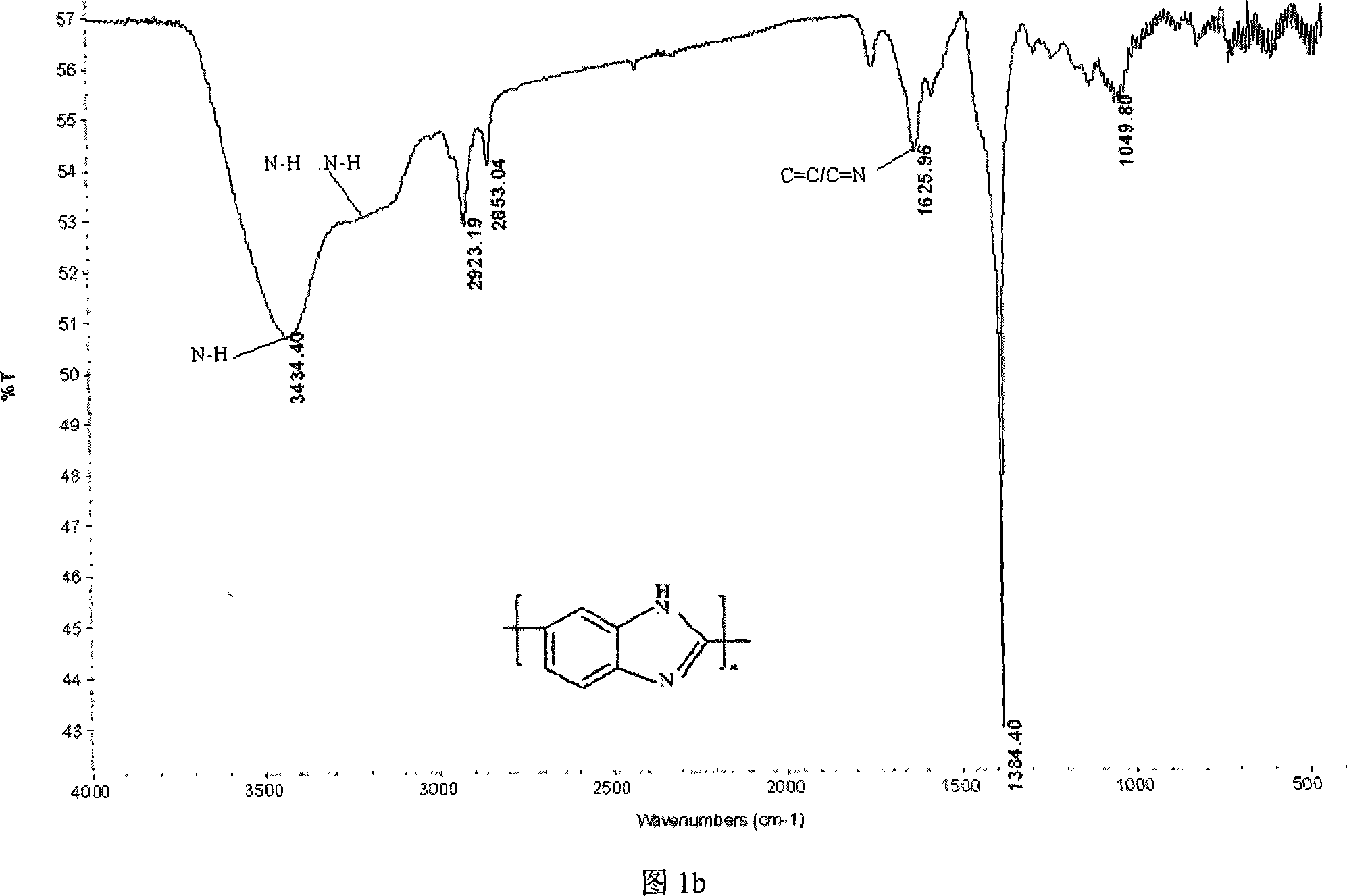Microwave synthesis of poly-2,2',5,5'-benzmidazole and poly-2,5-benzimidazole
A technology of microwave synthesis and benzimidazole, which is applied in the field of microwave synthesis of poly2, can solve the problems of difficult control of product polymerization degree and long time period, and achieve the effects of avoiding local overburning, fast heating speed and high efficiency
- Summary
- Abstract
- Description
- Claims
- Application Information
AI Technical Summary
Problems solved by technology
Method used
Image
Examples
Embodiment 1
[0036] (1) Add 50g polyphosphoric acid PPA (chemically pure, content: P 2 o 5 ≥80.0wt%), heated and stirred under nitrogen protection (flow rate: 45mL / min) to 140°C; accurately weighed 20mmol reactant 3,3'-diaminobenzidine (DAB 4HCl 2H 2(2, 97wt%) was slowly added in the round-bottomed flask, after it was dissolved and the HCl in it was volatilized completely, slowly added 20mmol of isophthalic acid (chemically pure, ≥99wt%);
[0037] (2) After stirring and mixing completely, move the reactant into a microwave oven, and program temperature rise: first 120°C, 2min; 140°C, 2min; 160°C, 2min; 170°C, 14min; then 180°C, 2min; Heating at 200°C for 154min, with a microwave power of 400W;
[0038] (3) The reaction product was poured into deionized water while it was hot, and there was obvious stringing phenomenon, and it was left to stand for 15 hours, washed with water until nearly neutral, and neutralized by adding saturated sodium bicarbonate solution;
[0039] (4) Suction filtr...
Embodiment 2
[0043] (1) Add 122g polyphosphoric acid PPA (chemically pure, content: P 2 o 5 ≥80.0wt%), heated and stirred under nitrogen protection (flow rate: 45mL / min) to 140°C; accurately weighed 48.8mmol reactant 3,3'-diaminobenzidine (DAB 4HCl 2H 2 (2, 97wt%) was slowly added in the round bottom flask, after it was dissolved and the HCl in it was volatilized completely, slowly added 48.8mmol of isophthalic acid (chemically pure, ≥99wt%);
[0044] (2) After stirring and mixing completely, move the reactant into a microwave oven, and program temperature rise: first 120°C, 2min; 140°C, 2min; 160°C, 2min; 170°C, 14min; then 180°C, 2min; Heating at 200°C for 68 minutes, the power of the microwave oven is 400W;
[0045] (3) The reaction product was poured into deionized water while it was hot, and there was obvious stringing phenomenon, and it was left to stand for 15 hours, washed with water until nearly neutral, and neutralized by adding saturated sodium bicarbonate solution;
[0046] ...
Embodiment 3
[0050] (1) Add 50g polyphosphoric acid PPA (chemically pure, content: P 2 o 5 ≥80.0wt%), heated and stirred under nitrogen protection (flow rate: 45mL / min) to 140°C; accurately weighed 20mmol reactant 3,3'-diaminobenzidine (DAB 4HCl 2H 2 (2, 97wt%) was slowly added in the round-bottomed flask, after it was dissolved and the HCl in it was volatilized completely, slowly added 20mmol of isophthalic acid (chemically pure, ≥99wt%);
[0051] (2) After the stirring and mixing are complete, move the reactant into a microwave oven, and program temperature rise: first 120°C, 2min; 140°C, 2min; 160°C, 2min; 170°C, 4min; then 180°C, 2min; Heating at 200°C for 76 minutes, with a microwave power of 400W;
[0052] (3) The reaction product was poured into deionized water while it was hot, and there was obvious stringing phenomenon, and it was left to stand for 15 hours, washed with water until nearly neutral, and neutralized by adding saturated sodium bicarbonate solution;
[0053] (4) Suc...
PUM
| Property | Measurement | Unit |
|---|---|---|
| glass transition temperature | aaaaa | aaaaa |
Abstract
Description
Claims
Application Information
 Login to View More
Login to View More - R&D Engineer
- R&D Manager
- IP Professional
- Industry Leading Data Capabilities
- Powerful AI technology
- Patent DNA Extraction
Browse by: Latest US Patents, China's latest patents, Technical Efficacy Thesaurus, Application Domain, Technology Topic, Popular Technical Reports.
© 2024 PatSnap. All rights reserved.Legal|Privacy policy|Modern Slavery Act Transparency Statement|Sitemap|About US| Contact US: help@patsnap.com










